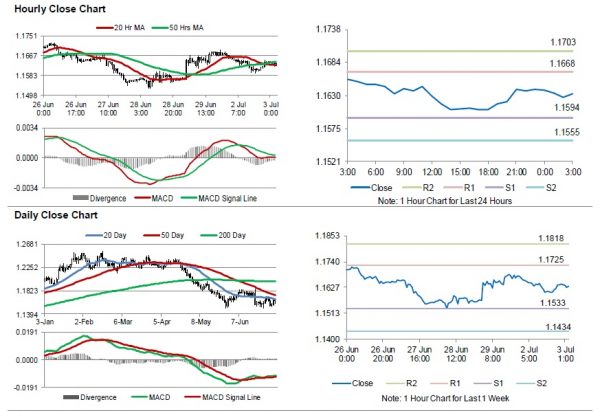For the 24 hours to 23:00 GMT, the EUR declined 0.16% against the USD and closed at 1.1640, amid political uncertainty in Germany concerning the migration policy.
Macroeconomic data revealed that Euro-zone’s final Markit manufacturing PMI dropped to an 18-month low level of 54.9 in June, compared to a reading of 55.5 in the previous month. Market participants had anticipated the PMI to fall to 55.0. The preliminary figures had indicated a decline to 55.0. Moreover, the region’s unemployment rate fell to a nine-year low level of 8.4% in May, compared to 8.5% in the prior month.
Meanwhile, Germany’s final manufacturing PMI eased to a level of 55.9 in June, in line with market expectations and confirming the preliminary print. In the prior month, PMI had registered a reading of 56.9.
In the US, data showed that final Markit manufacturing PMI eased to a level of 55.4 in June, compared to a reading of 56.6 in the prior month. Further, the nation’s construction spending advanced 0.4% on a monthly basis in May, less than market expectations. In the previous month, construction spending had recorded a revised rise of 0.9%. The ISM manufacturing activity index unexpectedly climbed to a level of 60.20 in June, compared to a level of 58.70 in the prior month.
In the Asian session, at GMT0300, the pair is trading at 1.1632, with the EUR trading 0.07% lower against the USD from yesterday’s close.
The pair is expected to find support at 1.1594, and a fall through could take it to the next support level of 1.1555. The pair is expected to find its first resistance at 1.1668, and a rise through could take it to the next resistance level of 1.1703.
Moving ahead, investors would closely monitor Euro-zone’s retail sales data and producer price index, both for May, due to be released in a few hours. Later in the day, the US factory orders and flash durable goods orders, both for May, will pique significant amount of investor attention.
The currency pair is showing convergence with its 20 Hr and 50 Hr moving averages.














